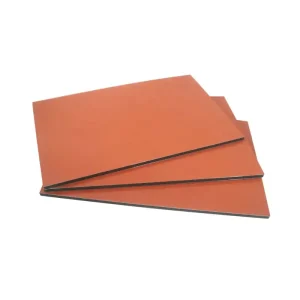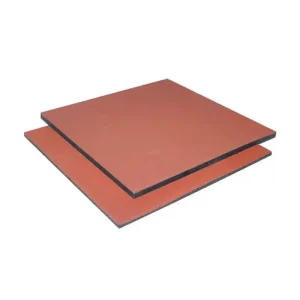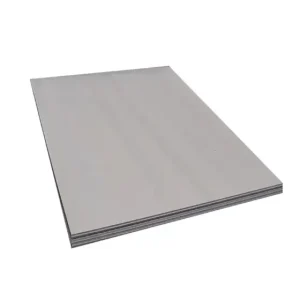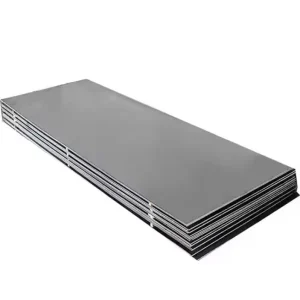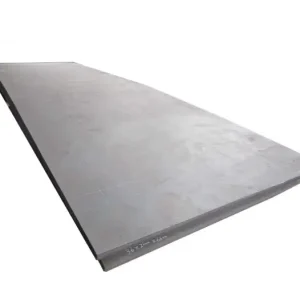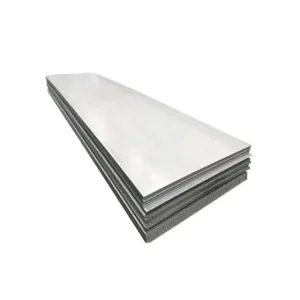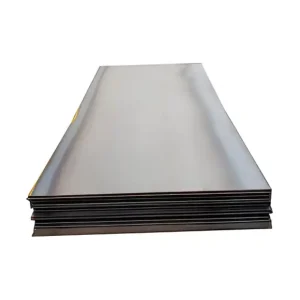Abrasion Resistant Steel
Products
For most heavy-wear industrial uses — mining, bulk-handling, earthmoving and recycling — abrasion-resistant (AR) steels in the Brinell hardness range 400–500 HBW (AR400 / AR450 / AR500) offer the best balance of service life, formability and cost. Branded wear steels (for example SSAB Hardox® series) provide tighter quality controls, guaranteed toughness and datasheet traceability that typically reduce total life-cycle cost despite a higher initial plate price; choose higher hardness (AR500/AR550) only when component geometry and fabrication limits allow and when abrasive wear dominates over impact.
What “abrasion-resistant steel” means
“Abrasion-resistant” steel is a family of hot-rolled alloy steels engineered and heat treated so the product achieves a specified through-thickness hardness and associated toughness. Unlike ordinary structural plate (specified by yield strength), AR steels are specified primarily by Brinell hardness (HBW) because hardness correlates strongly with resistance to many abrasive wear mechanisms. When wear occurs primarily from sliding, cutting or micro-ploughing, higher hardness usually extends component life. However, hardness is not the only property that matters — toughness and residual stress control are vital where impact, bending or cold forming is present.
Key performance metrics
-
Brinell hardness (HBW) — main grade designator (e.g., 400, 450, 500).
-
ASTM G65 (dry sand/rubber wheel) volume loss — widely used comparative abrasion test.
-
Charpy impact energy at temperature — required for impact-prone equipment.
-
Through-thickness hardness uniformity (to avoid surface-only hardening).
How abrasion is measured (standards and meaning)
The most widely referenced lab method for ranking materials under sliding abrasion is ASTM G65 — “Standard Test Method for Measuring Abrasion Using the Dry Sand/Rubber Wheel”. G65 produces volume-loss numbers that rank materials under a controlled set of conditions; lower volume loss = higher abrasion resistance for that test geometry. Note that different test methods (e.g., ASTM G105 pin-on-disk, Taber Abraser) simulate different field conditions, so always compare materials tested with the same protocol.
Practical implication: use G65 data or supplier-run G65 comparisons when selecting plates for sliding/dusty/abrasive sand/grit conditions.
Typical commercial grades and hardness bands
| Commercial/Trade name | Nominal hardness (HBW) | Common shorthand | Typical application focus |
|---|---|---|---|
| Hardox® 400 (SSAB) | ~400 HBW | AR400 / Hardox 400 | General wear parts, moderate impact |
| Hardox® 450 (SSAB) | ~450 HBW | AR450 / Hardox 450 | Higher abrasion with still-good formability |
| Hardox® 500 / Hardox® 500 Tuf | 475–505 HBW | AR500 / Hardox 500 Tuf | Severe abrasion, high payload, limited forming |
| AR235 / AR300 | 235–300 HBW | AR235 (light wear) | Liners, moderate wear where ductility matters |
| AR550 / AR600 | ~550–600 HBW | AR550 / AR600 | Extreme wear (limited use where impact is low) |
Notes: Hardox (SSAB) is a well-known branded family with detailed datasheets and guaranteed properties; generic “AR” plates from local mills follow similar hardness-based naming conventions but quality and guaranteed toughness can vary. For the branded products and grade guidance see SSAB product information.
Metallurgy and microstructure that control wear performance
Abrasion resistance arises from a combination of martensitic/tempered microstructure, alloying content (C, Mn, Cr, Si, sometimes Mo/Ni), and thermal processing (controlled quench & temper). Typical features:
-
Carbon and alloying: Raise hardenability; carbon increases hardness but reduces weldability if uncontrolled.
-
Martensite with tempered microstructure: Provides high hardness while maintaining some toughness.
-
Clean, controlled rolling and quench/temper cycles: Ensure through-thickness hardness and reduce brittle microstructural bands.
Recent peer-review work on modern quenched-and-tempered wear plates (including Hardox Extreme series) shows microstructure and process control strongly influence both wear and weldability—hence branded mills publish microstructural and toughness guarantees.
Mechanical properties and processing limits
| Property | AR400 (typical) | AR450 (typical) | AR500 (typical) |
|---|---|---|---|
| Brinell hardness (HBW) | 360–444 | 430–480 | 470–540 |
| Yield strength (approx MPa) | 800–1000 | 900–1150 | 1000–1300 |
| Elongation (%) | 10–22 (varies with thickness) | 8–18 | 6–12 |
| Impact toughness (Charpy) | Often guaranteed for branded grades | Often guaranteed (depends on product) | Lower at same thickness—check datasheet |
| Weldability | Good (with preheat controls) | Moderate | More restrictive — follow supplier guide |
| Cold forming | Good | Moderate | Limited — springback and cracking risk |
(Values are representative ranges; always request supplier datasheet for exact guarantees and through-thickness numbers.)
Matching grade to application
| Environment | Dominant damage mode | Recommend grade(s) | Rationale |
|---|---|---|---|
| Dump truck body, payload maximization | Sliding abrasion, moderate impact | AR450 / Hardox 450 or Hardox 500 Tuf | Good abrasion with formability — can reduce thickness for weight |
| Crusher liners, impact + abrasion | Combined impact & abrasion | AR400 (with thicker sections) or wear-resistant castings | Cast liners or tougher grades manage impact better |
| Chutes, hoppers, silos (sliding ore/sand) | Low impact, high sliding wear | AR500 / AR550 | Highest hardness gives longest life |
| Excavator bucket lip | High impact & gouging | AR400 / Hardox 400 or welded overlays | Balance toughness and hardness |
| Recycling shredder / scrap handling | High impact + abrasive edges | AR400/AR450 or hardfacing overlay | Abrasive edges and impacts demand toughness |
Manufacturing, cutting, welding and fabrication best practices
Practical rules to avoid weakening AR plate or creating brittle zones:
-
Thermal cutting: Plasma, oxy-fuel or laser are all used; expect a heat-affected zone (HAZ). Control cutting speed and use correct consumables. Branded suppliers often provide cutting recommendations.
-
Welding: Use low hydrogen consumables, preheat where recommended (thicker plates and higher hardness require preheat), and follow supplier’s welding procedure specification (WPS). Overheating the HAZ can soften or embrittle material.
-
Forming/bending: AR400 can be bent cold within limits; AR500 is far less forgiving — consider specialist press brakes, heat-bend or pre-form before quenching where possible.
-
Machining: High hardness reduces machinability — use carbide tooling, rigid machines and slower feeds for milling and drilling.
-
Repair options: When field repair is necessary, prefer matched consumables and follow controlled cooling to avoid cracking.
Manufacturers and branded steelmakers publish detailed fabrication guides — always obtain and follow them.
Surface engineering, liners and overlays — when to use alternatives
Sometimes a wear solution using base AR plate isn’t optimal:
-
Hardfacing overlays (weld overlays of alloys, tungsten carbide deposits): good where localized wear occurs and replaceable overlays make maintenance cheaper.
-
Ceramic or composite liners: appropriate where very high hardness and chemical resistance are required and where weight or brittleness is tolerated.
-
Rubber or polymer liners: for mild abrasive flow or where noise reduction and corrosion protection are required.
Choice depends on abrasive type, impact, temperature, and maintenance model.
Failure modes, inspection and maintenance
Common failure modes: gouging, abrasive smoothing, fatigue cracking (from repeated impacts), and HAZ cracking from improper welding. Useful inspection checklist:
-
Measure thickness loss at multiple locations and compare against baseline.
-
Check for HAZ microcracks after welding repairs.
-
Monitor fasteners and welds for loosening from differential wear.
-
For critical components, set replacement thresholds expressed as remaining thickness or volume loss.
A predictive maintenance approach using measured wear rates versus known service life can optimize replacement intervals and reduce downtime.
Cost, life-cycle analysis and procurement tips
Initial plate price is only part of the story. Consider:
-
Service life per unit mass — higher-hardness plates can be thinner for the same life and therefore lower in installed weight and freight. SSAB notes that abrasion-resistant steels can last up to 4× longer than mild steel in many applications.
-
Fabrication premium — branded steels often cost more per tonne but include datasheets, guaranteed toughness and mill traceability; these reduce acceptance risk.
-
Total cost of ownership (TCO) — compute installed cost + downtime + replacement + fuel/weight penalties (lighter plates reduce vehicle fuel consumption).
-
Procurement language: require mill test certificate (MTC), thickness tolerances, guaranteed hardness (Brinell range), guaranteed Charpy result at specified temperature, and G65 test data if available.
Environmental and recycling considerations
AR steels are conventional steels and are fully recyclable in standard scrap streams. Using longer-life wear plates reduces material consumption and energy per tonne of work performed. When hardfaced or clad with non-ferrous overlays, recycling routes must be considered because alloy additions (carbides) change melting behavior.
Short case studies
Mining haul-truck bed (open pit): After switching from mild steel to AR450 for the body liner and AR500 for the tailgate cutting edge, a mine reported extended replacement intervals and lowered maintenance time; the thinner AR plates reduced vehicle weight and increased payload per trip (common outcome with branded wear steels).
Crusher liner: Crushers combine high impact plus abrasion; many operators prefer cast manganese or layered solutions (tough base + hard overlay) rather than a single high-hardness plate, because cast shapes handle impact and allow bolted replacement.
Recycling shredder: High impact from mixed scrap requires a tough, impact-resistant plate (AR400/AR450) and periodic hardfacing — outright use of AR500 can cause brittle failures in this service.
Quick selection checklist
Checklist (yes/no)
-
Is abrasive sliding the dominant damage? → consider AR500/AR550.
-
Is impact/edge gouging significant? → favour AR400/AR450 or overlays.
-
Do you need tight dimensional tolerances/datasheet traceability? → order branded plate (e.g., Hardox).
-
Will parts be cold-formed? → limit hardness or specify formable grade (AR400F).
-
Are welding and repairs needed in the field? → request supplier welding guide and select consumables.
Sample procurement clause:
Supply quenched-and-tempered abrasion-resistant steel plate, nominal hardness 450 HBW (±20 HBW), through-thickness hardness guaranteed, with mill test certificate (EN 10204 3.1 or equivalent), Charpy V-notch impact guarantee of ≥27 J at –20 °C (if required), and manufacturer’s fabrication and welding instructions. Material to conform to accepted AR product family standards; alternate suppliers allowed only with equivalent G65 comparative data.
FAQs
-
What is the difference between AR400 and Hardox 400?
AR400 is a generic hardness-based designation. Hardox 400 is a branded product with additional guarantees on toughness, flatness and mill traceability. -
Does higher Brinell always mean longer life?
For pure sliding abrasion — usually yes. But when impact, edge loading or forming are present, very high hardness can shorten component life due to brittle failure. -
Can AR plate be welded to structural steel?
Yes, with appropriate consumables and preheat/post-weld treatment recommended by the plate supplier. -
What test should I ask for to compare wear performance?
Request ASTM G65 dry sand/rubber wheel results or supplier-run G65 comparisons under matching conditions. -
Is AR plate magnetic?
Yes. modern AR steels are ferrous and magnetic. -
Can I bend AR500 cold?
Cold bending AR500 is limited and risky; check manufacturer guidance — for many parts, heat-forming or using a lower-hardness grade is safer. -
How to pick between AR plate and hardfacing?
Use AR plate for broad area wear; pick hardfacing where localized, replaceable wear zones or very high localized hardness is needed. -
Are AR plates compliant with common structural standards?
AR plates are steel products and can be specified with EN/ASTM acceptance standards and MTCs; confirm required test certificates in purchase order. -
Does AR steel corrode faster?
Abrasion resistance is separate from corrosion resistance. Some AR steels include chromium which marginally improves corrosion resistance, but for corrosive environments consider stainless wear alloys or coatings. -
How much life improvement can I expect over mild steel?
Results vary; SSAB and field reports commonly cite up to 3–4× longer life in abrasive sliding applications for properly selected AR steel vs. mild structural steel.

